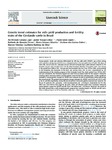Use este identificador para citar ou linkar para este item:
http://www.alice.cnptia.embrapa.br/alice/handle/doc/1059624Registro completo de metadados
| Campo DC | Valor | Idioma |
|---|---|---|
| dc.contributor.author | CANAZA-CAYO, A. W. | pt_BR |
| dc.contributor.author | COBUCI, J. A. | pt_BR |
| dc.contributor.author | LOPES, P. S. | pt_BR |
| dc.contributor.author | TORRES, R. de A. | pt_BR |
| dc.contributor.author | MARTINS, M. F. | pt_BR |
| dc.contributor.author | DALTRO, D. dos S. | pt_BR |
| dc.contributor.author | SILVA, M. V. G. B. | pt_BR |
| dc.date.accessioned | 2016-12-29T11:11:11Z | pt_BR |
| dc.date.available | 2016-12-29T11:11:11Z | pt_BR |
| dc.date.created | 2016-12-29 | pt_BR |
| dc.date.issued | 2016 | pt_BR |
| dc.identifier.citation | Livestock Science, v. 190, p. 113-122, 2016. | pt_BR |
| dc.identifier.uri | http://www.alice.cnptia.embrapa.br/alice/handle/doc/1059624 | pt_BR |
| dc.description | Annual genetic trends and selection differentials for 305-day milk yield (305MY), age at first calving (AFC), and first calving interval (FCI) were estimated by four selection paths [sires of bulls (SB), dams of bulls (DB), sires of cows (SC), and dams of cows (DC)] for Girolando dairy cattle in Brazil. A total of 12,739 lactation records were obtained from the Brazilian Girolando Breeders Association with cows calving in the period from 2000 to 2011. Two periods were involved: the first, from 1979 to 1996, corresponding to the formation and expansion of the herd, and second, from 1997 to 2007, characterized by the implementation of the breeding program of the Girolando breed. The whole period from 1979 to 2007 was also considered. The Wombat program was used to fit an animal model for the analyses. Estimated breeding values were extracted to calculate genetic trends for the four selection paths. Greater significant estimates of annual genetic changes for 305MY were obtained for the SC and SB paths, being both during the second period. The greatest annual genetic change estimates for 305MY were 43.06 and 101.97 milk/yr for SC and DB, respectively, during the second period. A favorable genetic response was found for the SB and SC paths for AFC, averaging −4.24 (second period) and −0.32 day/yr, respectively. For FCI, this effect was from 0.04 to 0.18 range for all paths. When all selection paths were combined, estimated annual genetic changes for 305MY and AFC were 7.40 milk/yr and −0.13 day/yr. Therefore, the results of this study showed that a well-designed genetic program has a positive impact on 305MY and AFC and a little or without impact on FCI in Girolando cattle over a 28-yr period. | pt_BR |
| dc.language.iso | eng | eng |
| dc.rights | openAccess | eng |
| dc.subject | Selection differential | pt_BR |
| dc.subject | Selection path | pt_BR |
| dc.title | Genetic trend estimates for milk yield production and fertility traits of the Girolando cattle in Brazil. | pt_BR |
| dc.type | Artigo de periódico | pt_BR |
| dc.date.updated | 2017-02-22T11:11:11Z | pt_BR |
| dc.subject.nalthesaurus | Girolando | pt_BR |
| dc.subject.nalthesaurus | Genetic improvement | pt_BR |
| dc.subject.nalthesaurus | genetic trend | pt_BR |
| riaa.ainfo.id | 1059624 | pt_BR |
| riaa.ainfo.lastupdate | 2017-02-22 | pt_BR |
| dc.contributor.institution | Ali William Canaza-Cayo, UFV; Jaime Araújo Cobuci, UFRGS; Paulo Sávio Lopes, UFV; Robledo de Almeida Torres, UFV; MARTA FONSECA MARTINS, CNPGL; Darlene dos Santos Daltro, UFRGS; MARCOS VINICIUS GUALBERTO B SILVA, CNPGL. | pt_BR |
| Aparece nas coleções: | Artigo em periódico indexado (CNPGL)  | |
Arquivos associados a este item:
| Arquivo | Descrição | Tamanho | Formato | |
|---|---|---|---|---|
| Cnpgl2016LivSciGenetic.pdf | 716,46 kB | Adobe PDF |  Visualizar/Abrir |









